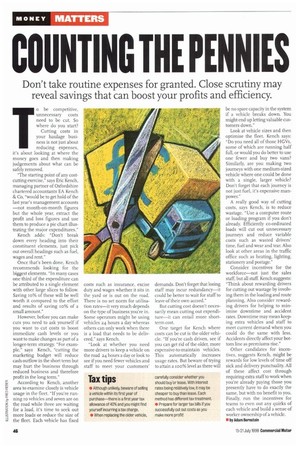COUNTING THE PENNIES
Page 48

If you've noticed an error in this article please click here to report it so we can fix it.
Don't take routine expenses for granted. Close scrutiny may reveal savings that can boost your profits and efficiency.
To be competitive, unnecessary costs need to be cut. So where do you start? Cutting costs in your haulage business is not just about reducing expenses, its about looking at where the money goes and then making judgements about what can be safely removed.
"The starting point of any costcutting exercise," says Eric Kench, managing partner of Oxfordshire chartered accountants EA Kench & Co, "would be to get hold of the last year's management accounts —not month-on-month figures but the whole year, extract the profit and loss figures and use them to produce a pie chart illustrating the major expenditures."
Kench adds: "Don't break down every heading into their constituent elements, just pick out overall headings such as fuel, wages and rent."
Once that's been done, Kench recommends looking for the biggest elements. "In many cases one third of the expenditure can be attributed to a single element with other large slices to follow. Saving to% of these will he well worth it compared to the effort and results of saving to% of a small amount."
However, before you can make cuts you need to ask yourself if you want to cut costs to boost immediate cash levels or you Want to make changes as part of a longer-term strategy. "For example," says Kench, "cutting the marketing budget will reduce cash outflow in the short term but may hurt the business through reduced business and therefore profit in the long term."
According to Kench, another area to examine closely is vehicle usage in the fleet. "If you're running to vehicles and seven are on the road while three are waiting for a load, it's time to seek out more loads or reduce the size of the fleet. Each vehicle has fixed
costs such as insurance, excise duty and wages whether it sits in the yard or is out on the road. There is no set norm for utilisation rates—it very much depends on the type of business you're in. Some operators might be using vehicles 24 hours a day whereas others can only work when there is a load that needs to be delivered," says Kench.
"Look at whether you need more drivers to keep a vehicle on the road 24 hours a day or look to see if you need fewer vehicles and staff to meet your customers'
Tax tips
• Although unlikely, beware of selling a vehicle within its first year of purchase—there is a first year tax allowance of 40% and you might find yourself incurring a tax charge.
• When replacing the older vehicle,
demands. Don't forget that losing staff may incur redundancy—it could be better to wait for staff to leave of their own accord."
But cutting cost doesn't necessarily mean cutting out expenditure—it can entail more shortterm cost.
One target for Kench where costs can be cut is the older vehicle. "If you're cash driven, see if you can get rid of the older, more expensive-to-maintain vehicles. This automatically increases usage rates. But beware of trying to attain a r00% level as there will
carefully consider whether you should buy`or lease. With interest rates being relatively low, it may be cheaper to buy than lease. Each method has different tax treatment.
• Prepare for larger tax bills if you successfully out out costs as you make more profiti
be no spare capacity in the system if a vehicle breaks down. You might end up letting valuable customers down."
Look at vehicle sizes and then optimise the fleet. Kench says: "Do you need all of those HGVs, some of which are running half full, or would you do better to use one fewer and buy two vans? Similarly, are you making two journeys with one medium-sized vehicle where one could be done with a single, larger vehicle? Don't forget that each journey is not just fuel, it's expensive manpower."
A really good way of cutting costs, says Kench, is to reduce wastage. "Use a computer route or loading program if you don't already. Efficiently co-ordinated loads will cut out unnecessary journeys and reduce variable costs such as wasted drivers' time, fuel and wear and tear. Also look at other areas in the traffic office such as heating, lighting, stationery and postage."
Consider incentives for the workforce—not just the sales staff, but all staff. Kench suggests: "Think about rewarding drivers for cutting out wastage by involving them in the loading and route planning. Also consider rewarding drivers for helping to minimise downtime and accident rates. Downtime may mean keeping extra vehicles and staff to meet current demand when you could do the same with less. Accidents directly affect your bottorn line as premiums rise," Other candidates for incentives, suggests Kench, might be rewards for low levels of time off sick and delivery punctuality. All of these affect cost through requiring extra staff to work when you're already paying those you presently have to do exactly the same, but with no benefit to you. Finally, run the incentives for teams to even out any quirks of each vehicle and build a sense of worker ownership of a vehicle.
• by Adam Bernstein












































































































